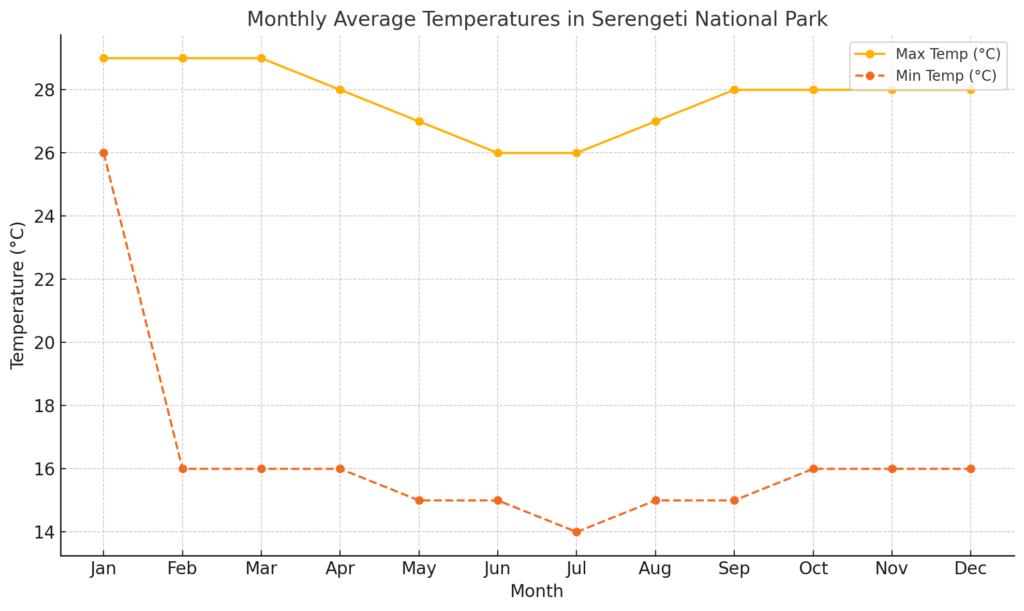Serengeti National Park, famous for its expansive landscapes and incredible wildlife, experiences a diverse range of weather patterns throughout the year. Understanding these patterns is essential for planning your safari and ensuring you’re prepared for the conditions at different times of the year. The park’s climate is influenced by its altitude, proximity to the Indian Ocean, and location in East Africa. This guide will help you understand Serengeti’s weather, seasonal variations, and how to prepare for your visit.
Seasons of the Serengeti: A Year-Round Safari Destination
Serengeti National Park enjoys a generally pleasant and mild climate throughout the year, but there are distinct seasonal shifts that can affect both your experience and the movement of the wildlife. The park’s elevation, ranging from 920 to 1,850 meters (3,000 to 6,000 feet) above sea level, keeps the temperatures moderate despite its location close to the equator. Here’s what to expect:
- Cool and Dry Season: May to August
- This is the driest time of the year, characterized by cool temperatures, especially at night and in the early mornings.
- Temperatures range from a refreshing 15°C to 27°C (59°F to 80°F), making it a comfortable time to enjoy game drives without worrying about the heat.
- This period is ideal for watching large predator action, as the sparse vegetation makes it easier to spot lions, cheetahs, and leopards. Wildlife tends to gather around permanent water sources, making for easier sightings.
- Warm and Dry Season: September to October
- As the months progress into September and October, the temperatures rise slightly, with daytime highs reaching 28°C to 30°C (82°F to 86°F).
- The landscape is still dry, with occasional breezes, and animals can be spotted congregating near waterholes. This is a great time to witness the tail end of the Great Migration as herds make their way toward the Maasai Mara.
- Hot and Wet Season: November to April
- The rains begin in November, bringing a welcome change to the dry plains. The short rains, which last until December, are usually light and brief, refreshing the landscape without disrupting safari activities.
- Temperatures during the rainy season can rise to 30°C (86°F) during the day, but cool down to about 16°C (61°F) at night.
- The long rains arrive in March and continue through May, with heavier and more consistent rainfall. This period, known as the “green season,” transforms the Serengeti into a lush paradise, with vibrant greenery and plentiful wildlife.
Temperature Ranges in Serengeti
The Serengeti National Park enjoys a surprisingly moderate and pleasant climate, considering its proximity to the equator. While many might envision the Serengeti as sweltering, the park’s altitude creates a more temperate environment. Daytime temperatures rarely exceed 30°C (86°F) even during the hottest months, with the hottest periods typically occurring between November and March. Nights and early mornings, however, can be quite cool, especially during the dry season from May to August, with temperatures occasionally dipping to around 13°C (55°F). This temperature variation offers a refreshing break for safari-goers, making both early morning and late afternoon game drives quite comfortable. The temperature shifts not only influence visitor comfort but also impact animal behavior, as many species become more active during cooler hours, offering an unforgettable experience in this iconic ecosystem.
Here is a table with month-to-month average maximum and minimum temperatures in SNP:
| Month | Max °C | Min °C |
|---|---|---|
| JAN | 29 | 26 |
| FEB | 29 | 16 |
| MAR | 29 | 16 |
| APR | 28 | 16 |
| MAY | 27 | 15 |
| JUN | 26 | 15 |
| JUL | 26 | 14 |
| AUG | 27 | 15 |
| SEP | 28 | 15 |
| OCT | 28 | 16 |
| NOV | 28 | 16 |
| DEC | 28 | 16 |
Average daytime temperatures range between 26°C and 30°C (79°F and 86°F) depending on the season. The hottest months, November to March, can see temperatures approaching 37°C (98°F) in the afternoon, particularly in the lower-lying areas.
At night and in the early mornings, temperatures can drop significantly, especially from May to August, when they can fall to around 13°C (55°F). Visitors should pack layers to stay comfortable during chilly game drives at dawn.
Temperatures in Serengeti and Masai Mara are similar but slightly differ due to altitude. Serengeti altitude being lower at 920 to 1800 meters experiences warmer days, reaching 29-30°C (84-86°F) during its hottest months, with nights dropping to 13-16°C (55-60°F). Masai Mara, at a higher altitude of 1500 meters to 2100 meters, has cooler days around 25-28°C (77-82°F) and colder nights, often dropping to 10-12°C (50-54°F). Both regions offer mild, comfortable weather ideal for wildlife viewing year-round.

The warmer temperatures in Serengeti lead animals to seek shade and water, while the cooler Masai Mara allows for more activity during early mornings and evenings. Predators in both regions hunt during cooler hours, but Serengeti’s heat shortens hunting windows. These temperature differences also influence migration patterns, with herds moving between the two areas for optimal conditions.
Rainfall and Its Impact on Wildlife
Serengeti National Park experiences an average annual rainfall ranging from about 400 mm in the dry southeastern plains to around 1,200 mm in the wetter northwestern regions near the Kenyan border. The variation in rainfall is largely due to the region’s geography and prevailing winds. The southeastern plains, located in the rain shadow of the Ngorongoro Crater and Meru-Kilimanjaro mountains, receive less rain as the south-easterly winds carrying moisture from the Indian Ocean rise over these highlands, causing condensation and rainfall before reaching the plains.
In contrast, the northwestern Serengeti benefits from moisture drawn from Lake Victoria, where shifting winds bring additional rain. This leads to a distinct rainfall gradient across the park, with the northern and western regions being lusher and greener compared to the drier southern plains. Rainfall is concentrated in two periods: the short rains from November to December and the long rains from March to May, with April typically being the wettest month. The short rains rarely last long enough to interrupt a safari, but the long rains can lead to muddy roads, making some areas less accessible. However, this is also the season when the park is least crowded, offering a more intimate wildlife experience.
Here is a table showing the rainfall precipitation amounts in the Park throughout the year:
| Month | JAN | FEB | MAR | APR | MAY | JUN | JUL | AUG | SEP | OCT | NOV | DEC |
|---|---|---|---|---|---|---|---|---|---|---|---|---|
| Rainfall (mm) | 80 | 100 | 135 | 160 | 90 | 25 | 15 | 30 | 60 | 70 | 115 | 105 |

Here is a simple table representing the rainfall variation across different areas in Serengeti National Park:
| Area | Rainfall Level | Location |
|---|---|---|
| Kitale | High | Northern Serengeti |
| Billa | High | Northern Serengeti |
| Togoro | High | Northern Serengeti |
| Kirawira | Moderate | Western Serengeti |
| Musabi | Moderate | Western Serengeti |
| Banagi | Moderate | Central Serengeti |
| Simiyu | Low | Southeastern Serengeti |
| Tawiri | Low | Southeastern Serengeti |
In this table:
Low rainfall areas, found in the southeastern plains, are affected by the rain shadow of the Ngorongoro Highlands and Kilimanjaro range, making these regions drier and more arid.
High rainfall areas receive the most precipitation, benefiting from moist winds from Lake Victoria and lack the rain shadow effect.
Moderate rainfall areas, located in the central and western regions, receive enough moisture to support lush vegetation, though they experience less rainfall compared to the north.
Studies have also shown that animals are highly attuned to subtle environmental changes, often starting their movement before significant rain falls, possibly sensing changes in humidity or distant storms. This suggests an evolutionary adaptation to Serengeti’s dynamic climate, ensuring the survival of vast numbers of herbivores, which in turn sustains the park’s predator populations.
How Serengeti and Masai Mara rainfall differ;
- Seasonality: Serengeti has two rainy seasons (Nov-Dec, Mar-May), while Masai Mara experiences peak rains in April-May and November.
- Rainfall Amount: Serengeti ranges from 400 mm in the southeast to 1,200 mm in the northwest; Masai Mara receives 1,000-1,500 mm annually.
- Topographical Influence: Serengeti’s rain shadow from Ngorongoro and Meru-Kilimanjaro causes drier southeast and wetter northwest, while Masai Mara has more evenly spread rainfall due to less topographical interference.
- Impact on Wildlife: Serengeti’s dry season prompts the Great Migration to Masai Mara, which has more consistent rain and greener pastures year-round.
When to Visit: A Month-by-Month Breakdown
- January to February: These months are part of the hot and wet season, though rainfall is not as heavy as during the long rains. It’s a great time for witnessing the calving season, when thousands of wildebeest give birth, drawing predators like lions and hyenas.
- March to May: The long rains make this the least popular time for tourism, but it’s the perfect season for those who enjoy solitude and lush landscapes. Birdwatching is at its peak, and the Serengeti’s colors are more vibrant than ever.
- June to October: The dry season begins, offering the best wildlife viewing as animals congregate near remaining water sources. This is also when the Great Migration reaches its peak in the northern Serengeti, offering unforgettable river crossings at the Grumeti and Mara rivers.
- November to December: The short rains start, but this is also when the Great Migration returns to the central Serengeti. The landscape is beginning to green again, and the park is alive with the movements of millions of animals.
Tips for Safari-Goers
- Pack for Layers: While daytime can be warm, mornings and nights can be chilly, especially in the dry season. Bring light, breathable clothing for the day and warmer layers for the evenings.
- Bring Waterproof Gear: If you’re visiting during the rainy season, be prepared with waterproof jackets and boots, as brief downpours can happen suddenly.
- Sunscreen and Hats: Even on cloudy days, the sun can be strong, so it’s important to protect yourself with sunscreen and wide-brimmed hats.
- Plan According to Your Preferences: If you want to avoid crowds, visit during the long rains (March to May), when the park is quieter. For those looking to witness the Great Migration, plan your trip around the river crossings in June to October.
Serengeti’s weather is as diverse as its wildlife, but with the right preparation, any season can provide a magical safari experience. Whether you’re seeking the drama of the Great Migration or the tranquil beauty of the green season, Serengeti National Park’s climate is perfect for adventure year-round.
